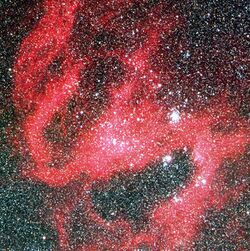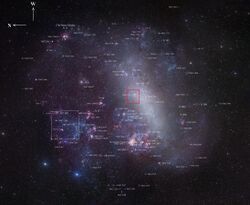Astronomy:N119
| Emission nebula | |
|---|---|
| H II region | |
 | |
| Observation data: J2000.0 epoch | |
| Subtype | Emission nebula |
| Right ascension | 5h 18m 45s[1] |
| Declination | −69° 14′ 03″[1] |
| Distance | 160,000 ly (50,000 pc) |
| Apparent magnitude (V) | 5.60 |
| Apparent dimensions (V) | 9′ 14″ × 12′ 15″[note 1] |
| Constellation | Dorado |
| Physical characteristics | |
| Absolute magnitude (V) | −13 (1040.7 erg/s)[1] |
| Dimensions | 131 × 175 pc (430 × 570 ly)[2] |
| Notable features | Unusual shape |
| Designations | N119, DEM L132,[1] PKS 0518-692, LHA 120-N 119[3] |
N119 (formally known as LHA 120-N 119) is a spiral-shaped H II region in the Large Magellanic Cloud. Its dimensions are large, at 131 x 175 pc (430 × 570 ly).[2] It contains several luminous stars including S Doradus, LH41-1042, and LMC195-1. Its peculiar S-shaped structure is difficult to explain with classical models.
Location
With a right ascension of 5h 18m 45s and a declination of −69° 14′ 03″,[1] this nebula may be found in the constellation of Dorado about 160 kly (50 kpc) away. Its apparent size is roughly 9′ 14″ × 12′ 15″. It lies at the northern side of the Large Magellanic Cloud's stellar bar, 15′ southeast of the center of rotation of the galaxy's neutral hydrogen.[2][4][5]
Structure
The nebula seems to be in an S-shape, but on closer inspection reveals to have extensions of the spiral arms, ending in a figure 8.[6] The unusual shape may be due to the combination of other nebula, or it may have been formed by perforation of the original molecular cloud by powerful stellar winds and explosions.
It may have also formed by a collision of two interstellar clouds, according to Annie Laval and Patricia Ambrocio-Cruz. The gas would have been compressed, forming the luminous stars seen today.[4]
Bubbles
File:N119 nebula.tif N119 contains several bubble-shaped nebulae: DEM L132a; DEM L132b; DEM L123; and an unnamed WR nebula. In total the nebulosity of N119 spans 131 by 175 parsecs (430 ly × 570 ly).[2]
DEM L132a is 88 parsecs across and encompasses the two luminous blue variables S Doradus and R85. However, those stars do not emit sufficient ionising radiation to produce the observed shell, and no other hot luminous stars are seen within the shell. It may have been produced by one or both of the LBVs during an earlier phase of their evolution. DEM L132b is 52 parsecs wide and surrounds two class O giants or supergiants and numerous other hot stars, which comfortably produce the necessary ionising radiation and fast winds to sculpt the bubble from the surrounding interstellar material. The WR bubble nebula is a similar size to DEM L132b and is produced by Brey 21, a binary containing a WN3 star and a B-type supergiant. DEM L123 is 158 parsecs across and its origins are unclear. No sufficiently powerful stars have been detected inside it that could produce it with their stellar wind (as this would require the power of 44 O6 supergiants) and it is ten times too energetic to have originated from a typical supernova. This bubble may have been created by a hypernova.[2]
| Bubble Name | Exciting Star | RA of Star | Declination of Star | Spectral Type of Star | Radius of Bubble |
|---|---|---|---|---|---|
| WR Nebula | Br 21 | 05h 18m 19.3s | −69° 11′ 41″ | WN3 | 26 pc (84.8 ly) |
| DEM L123 | SNR? | - | - | - | 79 pc (257.6 ly) |
| DEM L132a | S Doradus | 05h 18m 14.4s | −69° 15′ 01″ | LBV | 44 pc (143.5 ly) |
| R85 | 05h 17m 56.1s | −69° 16′ 03″ | LBV | ||
| DEM L132b | Sk−69°104 (HDE 269357) | 05h 18m 59.5s | −69° 12′ 55″ | O7 III | 26 pc (84.8 ly) |
| LH 41-32 | 05h 19m 1.9s | −69° 13′ 07″ | O4 III |
Observational history
N119 was first catalogued by Karl Henize, an American Astronomer, when he made a list of Hα emission-line stars and nebulae in 1956. The full designation is LHA 120-N 119: the 119th nebula on Lamont–Hussey Observatory H-alpha (Lamont-Hussey Alpha) plate 120. Plate 120 covered the Large Magellanic Cloud while plate 115 covered the Small Magellanic Cloud. LHA 120-S 119 is a Wolf–Rayet star in another part of the LMC. There is no LHA 115-N 119 since fewer nebulae were found on the SMC plate.[7]
On March 25–26, 1999, The Wide Field Imager, a 67-million pixel digital camera at the MPG/ESO 2.2-m telescope at the La Silla Observatory took a picture of the nebula with a field of view of 31.49 x 30.64 arcminutes at a RA of 5h 18m 37.89s and a declination of −69° 24′ 23.27″, and orientation of north being 1.9° right of vertical. It did four exposures each in the B band (2 minutes each), the V band (2 minutes each), and the Hα band (20 minutes each).[4] It is available for download on ESO's website at 2,303 × 2,241 pixels.
Luminosity
N119 suffers from 0.20 magnitudes of extinction in the B (blue) band, 0.15 in the V (yellow-green) band, and 0.12 in the Hα (red) band.[1]
NGC 1910
N119 has an associated open cluster called NGC 1910 (also known as ESO 56-SC99). Its apparent magnitude is 11.2 and its apparent size is 1.54 arcminutes. It is inside N119 with a right ascension of 5h 18m 42.5s and a declination of −69° 14′ 12.1″.[8]
Notes
- ↑ Calculated based on size and distance
References
- ↑ 1.0 1.1 1.2 1.3 1.4 1.5 Lopez, Laura A.; Krumholz, Mark R.; Bolatto, Alberto D.; Prochaska, J. Xavier; Ramirez-Ruiz, Enrico; Castro, Daniel (2014). "The Role of Stellar Feedback in the Dynamics of H II Regions". The Astrophysical Journal 795 (2): 121. doi:10.1088/0004-637X/795/2/121. Bibcode: 2014ApJ...795..121L.
- ↑ 2.0 2.1 2.2 2.3 2.4 2.5 Ambrocio-Cruz, P.; Rosado, M.; Laval, A.; Le Coarer, E.; Russeil, D.; Amram, P. (July 22, 2008). "Kinematic field of the S-shaped nebula N119 in the LMC". Revista Mexicana de Astronomía y Astrofísica 44: 355. Bibcode: 2008RMxAA..44..355A. http://www.scielo.org.mx/pdf/rmaa/v44n2/v44n2a10.pdf.
- ↑ "LHA 120-N 119". SIMBAD. Centre de données astronomiques de Strasbourg. http://simbad.u-strasbg.fr/simbad/sim-basic?Ident=LHA+120-N+119.
- ↑ 4.0 4.1 4.2 "Beautiful Nebulae in the Large Magellanic Cloud". https://www.eso.org/public/news/eso9931/.
- ↑ "The View from La Silla". Scientific American. https://www.scientificamerican.com/article/the-view-from-la-silla/.
- ↑ Exploring The Southern Sky. Springer Science & Business Media. December 6, 2012. p. 53. ISBN 978-3-642-64877-9. https://books.google.com/books?id=9GHvCAAAQBAJ&q=N119+nebula&pg=PA52.
- ↑ Henize, Karl G. (May 5, 1956). "Catalogues of Hα-emission Stars and Nebulae in the Magellanic Clouds". Astrophysical Journal Supplement 2: 35. doi:10.1086/190025. Bibcode: 1956ApJS....2..315H.
- ↑ "NGC 1910". SIMBAD. Centre de données astronomiques de Strasbourg. http://simbad.u-strasbg.fr/simbad/sim-basic?Ident=NGC+1910.
External links
 |


